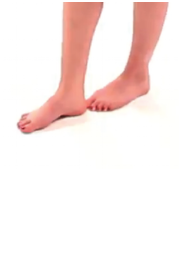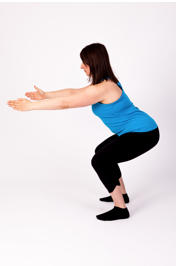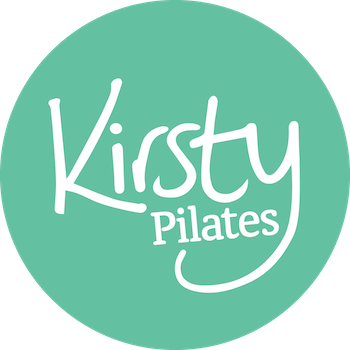Apart from using your spikey ball there are other things that you can practice daily to help improve your posture, move more easily and reduce pain.
I see most of my class members for 1 or maybe 2 hours a week. Out of a 168 hour week that’s only a very small part of your week!
Now that you have a better understanding of posture and core stability, try to transfer what you have learnt into everyday life. It doesn’t need to be time consuming and there are things that you can easily add in to your daily routine.
Here are a few ideas to get your started. Pick one and see if you can practice every day for the next week.
 Tandem Stance – When brushing your teeth
Tandem Stance – When brushing your teeth
Improve your balance and core strength at the same time as brushing your teeth.
Stand with one foot slightly in front of the other so that the heel of one foot is touching the big toe of the other. Stand tall and keep your weight even between both feet.
Hold this position for 30 secs on each side whilst brushing.

Spine Twist – Sitting at your work desk
This exercise can be practiced at your desk and help get movement into your thoracic spine (upper back) which can become achy and stiff when sitting for long periods.
Sit on the first half of your chair, feet on the floor (ideally shoes off if wearing heels) and lengthen spine. Place right hand onto left knee and rotate upper body to the left. Only rotate as far as feels comfortable. Repeat on opposite side.
Not suitable for osteoporosis/osteopenia
 Squat – When picking things up
Squat – When picking things up
This is a fantastic exercise for strengthening the buttocks, front of thigh and core muscles. It’s also the correct technique for lifting things up from the floor, helping to protect your back.
Start feet slightly wider than hip distance. Send hips back and lower. Keep your heels on the floor and knees track in line with the toes. Press through heels to stand.
 Pelvic Floor Exercise – Anywhere, anytime!
Pelvic Floor Exercise – Anywhere, anytime!
You can practice this exercise sitting in a chair, standing or lying on your back and nobody would know. If you have a weakened pelvic floor than practicing isolation exercises can help to strengthen these muscles.  Slowly draw up on your pelvic floor muscles as if you are trying to stop passing wind and the flow or urine. Then slowly relax the muscles. Avoid squeezing the buttocks or tilting the pelvis. Start with 3 sets of 10 repetitions daily.
Slowly draw up on your pelvic floor muscles as if you are trying to stop passing wind and the flow or urine. Then slowly relax the muscles. Avoid squeezing the buttocks or tilting the pelvis. Start with 3 sets of 10 repetitions daily.
Deep Breathing – When you need to relax
 Don’t wait until your next Pilates class to spend time relaxing.
Don’t wait until your next Pilates class to spend time relaxing.
Practice breathing at home for a few minutes and really try to focus on where you can feel the breath the most (e.g. ribcage expanding, nostrils, mouth). When your mind wanders then just bring your focus back to your breath.

